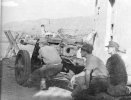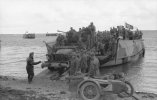Actually, the number of vehicles could be set to "0" in the scenario editor versions bundled with the original HTTR and COTA. Was that possibility removed?The Island Prize scenario should be edited to remove the two Motorized Anti-Tank Companies as they are useless where they arrive (due to not being able to move more than a few hundred meters because of the large slopes on the island) and there is no way to edit the vehicles out of the unit in the scenario editor. The idea that the Germans were landing 1.5 t trucks on the rocky coast of the island of Leros during the battle is far fetched anyway.
The Germans landed reinforcements several times (with one or another attempt denied by the Royal Navy and/or Leros' coastal batteries), but also artillery pieces during a reinforcement run on the 15th of November, using MFP landing crafts. These crafts were designed for Operation Seelöwe, originally, modified or even armed/upgraded until 1944, but extensively used during the Dodecanese campaign. German records corroborate that arty pieces were landed that day.
The MFPs' keels had a special shape that allowed for delivery even on beaches or rocky coasts.
In general, heavy equipment was supposed to be airlifted later on, but the airbase on Kos was put out of action by the Luftwaffe, then hastily repaired after Kos was captured, but subseq. packed with fighters to counter the RAF over Leros, IIRC, so a major second seaborne wave was supposed to deliver AA guns and artillery pieces to Leros. The Fallschirmjäger may have brought one or another recoilless gun, the Leichtgeschütze, as these guns could be attached to and dropped by Ju 52 transport planes during para drops.
Landing a regular 50-mm gun by ship, with the low possibility of approaching Allied tanks on Leros, doesn't appear to be likely, but it happened:
This is a Pak 38 on Leros. It's not clear when the picture was taken, it's most likely from the Bundesarchiv and the website where I found it included the pic with the filename "Battle of Leros". While the picture could have been taken after the battle, some direct fire capabilities (with some punch) against fortifications (is/was there a castle? "Fortress HQ"), bunkers or harbor installations were obviously deemed to be needed/useful:

The range in the background looks like the Northern bank of today's Leros Marina, so - if true - it looks like the gun is pointing at a position in Lakki, on the other side of the bay. The Germans invaded the town of Leros (just North of Lakki/the harbor), Alinda and Santa Marina on the 14th and 15th of November, if I am not mistaken.
A German Pionierlandungsboot (Engineer landing craft, 3 types: Pilabo 39, 40 and 41) in Russia, the Sd.Kfz (equipped with a flak-gun) is either pulling a disassembled FlaK 30 (or 38), or an ammo trailer (prob. the latter, as it used a similar carriage + as I fail to spot a barrel):

I am not sure if any Pilabos were deployed in the Aegean, but the transport capabilities were there and the MFPs in the Aegan and the Black Sea (MFPs and a hodgepodge mix of captured Italian navy vessels) were defin. used for the landings on Leros) were waaaaay bigger and had little draft (Type D: empty 1.18 meters of water, loaded 1.45 meters, only).
My guess would be that the initial landing contingents were mainly equipped with rifles, LMGs and light/medium mortars and - if at all - with Pak 36 guns, as they could be easily man-handled, but the MFPs offered enough space for tow vehicles or Krads, which were then used by the deployed Grenadier-Bns.
A number of pictures stored in the Bundesarchiv (federal archive) show Paras and Brandenburger gathering right after the battle, where then a number of messengers on Krads (motorbikes) show up.
While the British had to use runners to maintain contact across units, due to the lack of adequate signal equipment, the Germans could use a limited range of vehicles (they brought to the island) to tow heavy equipment, to ferry radio equipment and to perform messenger duties.
EDIT: The Germans landed tanks on Rhodes and landed quite a few tracked vehicles on Kos (this is a Kettenkrad with ammo trailer during the Battle for Kos, Osprey publishing, found in Anthony Rogers' blog covering Op. Accolade - https://ospreypublishing.com/blog/Operation_Accolade/ - most likely from the Bundesarchive):

German pictures from Leros show that troops usually had to walk. So you are right, it's not very likely that the German landed trucks in harm's way during the 2 major waves. It seems like they assembled/landed a mix of tracked/all-terrain vehicles and Krads instead, though.
British veteran William Moss (King’s Own Royal Regiment) stated that - after he was captured by a German unit during the battle - he and his comrades had to carry mortar rounds for the Germans and serve as human shields for the Germans near the Bay of Alinda, so mortars were def. used/landed early on. He was captured twice on Leros, managed to escape twice (where he made it back to British lines each time) and was put back on the line each time, before the British troops had to surrender. He was then brought to Austria to a POW camp and had to get a surgery in a German hospital, where then his sick report saved him from having to go on a death march across Germany when he was brought back to his transit camp, if I am not mistaken:
"Time went by, when we had to form up in single file, and were made to carry mortar bombs for the enemy and now we were being treated as ‘human shields’ amidst the fire of our own Troops."
http://www.kingsownmuseum.com/ww2-1ko-leros-moss.htm
The MFPs didn't end up beached, as they had 2 stern davits (E-engines) with anchors, which were used to pull the MFPs off the beaches, until their weak Diesel engines could be used again.
EDIT: These books may provide some detailed info, both authors interviewed British veterans, and Peakman sifted through lots of Royal Navy docs, it seems (the numerous detailed footnotes with hints at admiralty documents would suggest that, at least, I checked the preview on google books), and she quotes Bevan's work:
"Hitler's Island War: The Men Who Fought for Leros" by Julie Peakman
(it seems like Peakman provides a very detailed recollection/overview of the Dodecanese campaign)
"Travels with a Leros Veteran" by Pauline Bevan
Last edited: